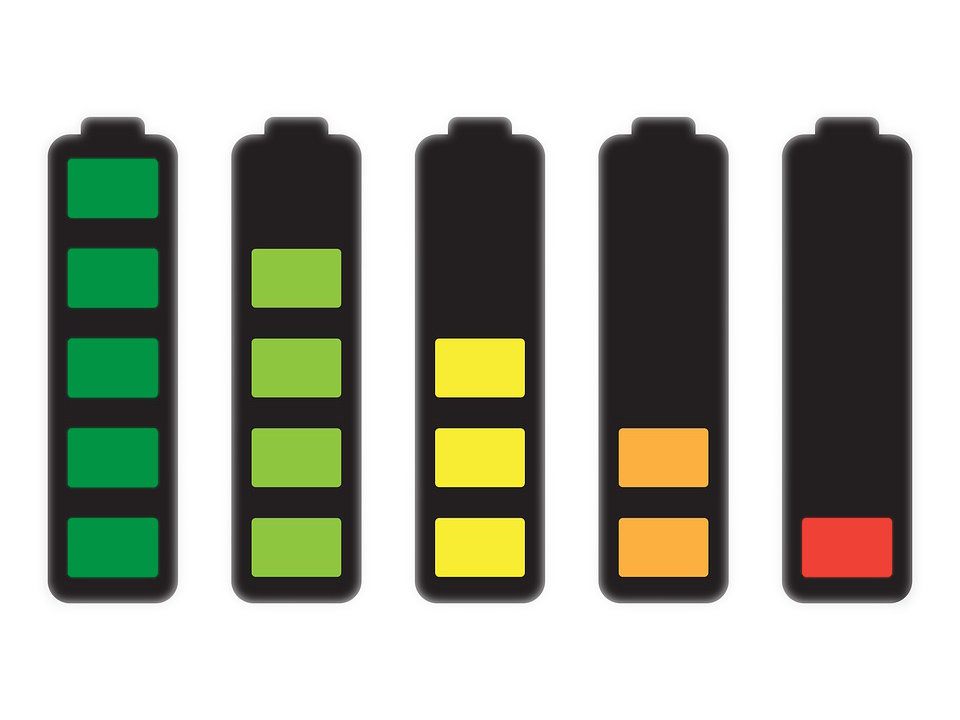Most high-quality LiPo-powered devices already do this at the hardware-level. The 100% level you see on the software is usually 80% actual charge on the battery.
Any way to tell? I just got a monster phone with a 22K mAh battery.
For Android, there are a multitude of apps, such as Wattz that will tell you the actual voltage of the battery. Full may be 4.2V or 4.35V depending on the chemistry used. ACCA (root required) will let you limit charge rates and stop charging at a certain percentage.
Staying under 4 volts (around 60% for most phone batteries) will vastly extend battery service life. 80% is a bit less extension, but still far better than charging to 100%.
i was looking for something like acca since forever
foss discoverability needs some mad work
I just use Home Assistant + smart switch
how do you do it?
Just set up an automatic to turn the switch off when the battery reaches 80%. Then back on when <75%.
that doesn’t answer the question of whether there’s a way to tell that their battery is limited to 80% on hardware level, though.
Unless it’s lying about the voltage itself, you can be pretty sure it’s not limited if it charges to 4.35V. 4.2 is a little more tricky if you don’t know for sure whether 4.2 is the full voltage for the cell.
That’s one hell of a battery
What phone is that‽
I don’t know, it says “Heavy duty” on the side.
Curious too
Thanks!
Late reply:
https://oukitel.com/pages/oukitel-wp33-pro
This replaces my old phone, Bluetooth speakers, battery banks, all that. Hella heavy, but so is all that other crap. I can drop it 5’ deep in the swamp, go down and get it. Still testing!
Jesus Christ that’s a car battery
omg kilo milliampere
k = 10^3 and m = 10^-3 so they will cancel out. It’s just Ah without any prefixes at that point.
Charge it from a smart power supply from battery at 1 to 100% then it can show you the number of mah/h it took to charge it.
I have this power supply which also has USB-C https://a.aliexpress.com/_mrChiQ6
Not sure how accurate this would be as charging is not 100% efficient. Also the amount of power the phone uses while charging would have to be taken into account as well.
My phone has a 10.8Ah battery and it’s huge, no idea how big that must be.
22Ah at 4.35V would be 96Wh, which iirc is just under the limit of 100Wh you can take on flights in the us, and thus the limit for basically all laptops.
mAh are a terrible way to measure capacity, look for watt-hours instead. You need to know the voltage for it to be a relevant measurement
It’s a pity they don’t offer the option to ‘supercharge’ to 100, so you get extended battery life when desired, when you know you will need it. Say, going camping, or plan to use the phone a lot for whatever reason.
Turn it up to 11!
Yes, they could call it spinal batt.
So can I charge my phone to 11?
It’s one more than ten, so yeah, it’s better.
Yea that’s what I’ve heard, and I personally keep stuff plugged in
It was a recent article by iFixit, so I thought I’d share it ¯\_(ツ)_/¯
Isn’t the charge limit of the battery arbitrary? The manufacturer can set whatever target voltage they want , so it’s meaningless to say they limit the battery to 80% when they decide what 100% is.
Yes
Do you have sources?
I don’t doubt the fact that they take some margin to extend the lifetime of the battery, but if we take iPhones as an example, they:
- charge at a slower rate when nearing 100%
- try to postpone charging the final 20% until the last moment before disconnecting from the wall outlet
- can be software capped at 80% by the user (in newer models)
This makes me suspect that that the margin between what’s reported in software as 100% and the actual capacity of the battery is less than 20%. This also makes sense from the standpoint of the consumer expecting a long battery life on their expensive high-end device, putting pressure on the companies to make the margin smaller and the charging algorithms smarter. Just my observations, of course.
This sounds like the battery and the charger’s problem to handle, not mine.
All this tech, all this automation for every damn thing, and people keep coming at me like I’m supposed to do everything manually with my fingers and eyes and maybe an alarm or something to keep me on schedule. No. Stop it.
Make the charger handle it, or shut up. Make the phone, the charger, and the battery handle it together, you know, with digital automation. Do not even mention it to me.
Your device manufacturer has designed it to break in as many ways as possible so you have to buy a new one.
Why do you think everyone switched to non-removable batteries?
If you don’t take responsibility for your device, you are just like the people that think not owning your own hardware is fine.
Why do you think everyone switched to non-removable batteries?
Well the purported reasoning is that less shielding is required. Seems plausible but IDK how true. I assume it’s partly true.
Some day you will learn that nearly every justification made by corporations like this is bullshit.
But I bet they’re glad you continue to spread it so loyally.
you continue to spread it so loyally
Whatever mate.
My comment acknowledges that it’s a dubious claim. I’d hardly call that spreading nonsense loyally.
Let the corps fuck you for a few more decades and you’ll be jaded like me.
More probably because the fucking bloodsuckers are getting better at it.
Jaded?
No, I think you’re just another snarky Lemmy commenter that doesn’t bother actually readying and understanding anything but trots out the same tired positions in thread after thread.
You really don’t have to be like this. You choose to be this way.
Samsung phones have the capability to do this. There’s a setting you can set to only charge to 80%. It looks like they mention that in the article.
Android phones in general have something called Adaptive Charging that attunes to when you normally need a full charge. For instance if you are charging at night while you’re sleeping it will charge slower than it would during the day to improve battery health.
Mine automatically charges to 80% if you have an alarm set, then it charges the rest in the last minutes.
Yup. If it’s such a huge issue, phones should only charge to 80% and report that to the user as 100%. But phone manufacturers won’t do that, because users want to be able to report the longest battery life possible when selling new phones. They don’t care that the charging habits are bad for battery longevity, because the user has already purchased the phone.
And they will purchase their next phone sooner if the battery on their old phones die early.
100% agree. Mate, there’s an another ongoing post on lemmy about autosaving documents, and how everyone seems to think that saving files with their fingers pressing keys on a keyboard is the best approach possible in 2024 because software just can’t do this reliably.
Of course everyone also knows better than their charger, battery and device.
You sound quite irritated. iFixit doesn’t even make phones. Direct it elsewhere.
He’s directing it to a forum of people under a topic regarding phones not being optimized to charge past 80%. Quite a fair frustration I’d say, since most people charge their phones while sleeping. The technology should stop charging automatically
Most Android phones do, hell even the experimental phones like PinePhone do. You just have to flip a toggle.
Except many like mine don’t have that option. The best they have is “optimized” charging that tries to only hit full when you go to unplug it.
I charge mine at night with an alarm on it for getting up in the morning, my dad however charges his multiple times a day as he puts it on when it only drops down to 95-80%.
I doubt this is directed at ifixit. I agree with their general comment, but at the same time device manufacturers have no incentive to make their devices last longer unless they are forced to.
Sir, this is a lemmy. It’s all about figuring out how to be the most outraged rather than the most rational.
Nah, that’s Reddit.
It’s funny how people think that the users here are substantially different than reddit users. It’s the same shit, just fewer of us and the political alignment is further left.
Let’s not bring that energy. Let’s try to be better.
Just kidding! Or am I?
No, it’s your problem.
The manufacturers correctly surmise that most people prefer a battery that holds it’s charge longer over the first year or so, rather than a battery that will last more years.
If your preferences differ from that of most people, then you need to exercise your preferences.
When you say “make it do x and y” who should be the person that does it? Without raising enough awareness of the problem, change will not happen. The only way for it to happen is that enough people is pissed off and changes brands.
deleted by creator
Just build phones with the understanding that batteries are consumables and make them easy to replace and standardized. Then swap in a new $5 battery when you need to so. Make the raw materials reclaimable too of course.
But then you aren’t forced to buy a new phone every few years?
What? No just a new battery. That’s the point.
That’s the point of what this guy is saying.
But the point of making batteries not easily removable (besides the waterproofing factor) is that when a repair shop charges them $150 to do it, lots of people will justify putting that money towards a new phone instead.
As someone who works on phones as a hobby, I’ve seen that the percentage of people who will either hire someone to do it or buy a different phone is near 100. It’s absolutely an intentional planned obsolescence.
Waterproofing is a lame excuse that I won’t accept from these manufacturers. It may be not as easy as just permanently gluing the thing together, but it’s definitely possible to have a sealed battery compartment.
For example cameras have been weatherproof for decades now. And you can both change the batteries and plug a bunch of stuff in them no problem.
They were being sarcastic and quoting something a phone manufacturer would say.
The money is in the software services nowadays anyway. Subscription AI bullshit, cloud n stuff.
No one is forced. Especially with fast charging.
Sure, if my battery lasts literally 30min, I’m totally not forced to buy a new phone. I’ll just fast charge my way through the world.
30 min? LMAO.
I literally know someone with this type of issue. Battery goes from like 70 to 20 in maybe 20 minutes
Their phone isn’t even that old
I know lemmy hates Apple but HOW?!
My five year old iPhone lasts all day, and is as fast as what I bought it?!
That battery has to be bad. I loved the shit out of my HTC Dream but that only went from 30% to 0 when the battery was BUSTIN
It was probably abused. I’ve never had a phone get that bad and I really do not think that is some widespread thing. Otherwise you’d see a lot of three year old EVs with a 20 mile range.
deleted by creator
not entirely sure tbh Just know their battery is shit at this point
Toward the end of my pixel 5’s life, the battery in it lasted about 10 minutes. The phone itself was 3 years old. It happens.
How?! I’m currently on a five year old phone that lasts all day with its original battery?!
Abuse or defects or environment. I’ve, for example, seen one phone which was constantly woken up (technical term in case it sounds odd) because of some event in the wireless signal and that made it use up the battery in a ridiculously short time. It was a combination of the way a network was set up, bad signal quality, and a firmware quirk. Clearly a defect, but hard to say whose. Forcing it to use some mode in the radio via settings circumvented that.
I get the feeling it has to do with how wireless charging works. On a wire, a phone can regulate how quickly it takes charge or whether it does at all. I don’t think phones are capable of that with wireless charging, which is exclusively how I charged my pixel 5 at night.
So it would get to 100% and stay there for several hours every single night. I didn’t realize it was bad at the time.
It could always just be that I was unlucky and got a defective battery to begin with. No way to know for sure.
This is what the new European bill is forcing manufacturers to do.
Batteries of handheld electronics have to be easily replaceable.
It’s a start but pretty weak.
Weak in which sense ?
Looking forward to the first lawsuit about this.
Do most people not have the option to protect their battery already?
I think that’s a Samsung feature
It’s built into my pixel as well. Shrug
You have an older Pixel or just rooted, maybe? My 7 on the latest vanilla Android doesn’t seem to have it, and this thread seems to say it’s not available in the stock os.
Is called adaptive charging
It’s on my pixel 7 pro at least
Ah, I see. I was focused on the 80% limiter for that “Maximum” setting, which I think is not an option on Pixel. But I see now that “Adaptive Charging” sounds like it does what that middle setting “Adaptive” does.
“Sleep time is estimated based on your usage patterns”
These systems exist on pretty much all modern phones, but they all work the same (shitty) way, by assuming your schedule is exactly the same every day and giving you zero programmable control.
And on iPhone the system expects you want your battery to charge over 80% on a daily basis. On a Samsung phone the system knows you don’t want to go past 80% at all, so it sets that as the new maximum.
Sure, but let’s also preserve current batteries as long as possible so we can lower our carbon foot print. We need to do both.
To be clear, you are still taking about rechargeable batteries right? I agree those should be replaceable. I sure as hell don’t think phone should use single use batteries!
Yes, 18650 or a standardized rectangular equivalent.
A standard would be nice… I mean all phones are basically the same size and shape.
Here’s my headline: Why obsessing over battery degradation is unhealthy and you should just do whatever is easiest for you
“hey here is a way to increase the life of your battery by possibly 400%.”
“OMG! Why are you obsessing over this!”
Seriously how dare they try to help us and educate us!
the 400% figure is extremely misleading and based on old assumptions and old battery tech.
Also it you’re not keeping the phone for 20 years then it doesn’t make sense to calculate “total electrons” over the absolute entirety of the battery “life”.
Agreed. If you’re a device maker and you haven’t considered the possibility of your users plugging in their devices for long periods of time in your design, then i feel that’s on you to improve your product.
I have enabled the option to limit charging to 85% on my Samsung, and last weekend I needed it to last for 2 days so I charged it to 100%. Easily made it. It’s nice to know you have that 100% when you need it .
If it shouldn’t be charged above 80%, then make 80% the new 100%. “But this one goes to 11”
They already did. The percentage range on your phone’s battery display is basically a usable range rather than an absolute range. The article talks about phone manufacturers making changes to their charging systems to optimize battery function, but the headline bit about not charging past a certain point has been taken into account by Android and iOS for ages.
Very few android phones actually have this feature, most manufacturers strip it
A lot of charging circuits and battery designs already do this transparently.
Yes. Batteries are bags of chemicals. They don’t really have percentages. Where you decide 100% is is somewhat arbitrary and up to the battery management.
What the system shows the user may be even a completely different number and there may be software adjustable values.
It’s inherently a made up number and a manufacturer can decide to be more brutal or more sparing in how they treat the chemicals.
I don’t like this article because it misses some of the more important details around how to lengthen your device’s life and why you may or may not want to keep your battery at a specific state of charge.
- State of charge is pretty arbitrary, your charging circuit could charge between 3.0V and 4.2V (pretty typical), or it could charge between 3.2V and 4.0V and still show 4.0V as being 100% charge. Different chemistries can have slightly (or significant in the case of LFP) different voltages. The cynic in me wouldn’t be surprised if eventually 100% becomes ~4.35V because it makes their device look better to tech reviewers, but then have it default to only charge to 4.2V because it still gives suitable device life.
- The most important factors in how long your device’s battery will last are temperature and how deeply you discharge the battery. Discharging your phone down until it dies does way more damage than keeping it charged at 100%.
- At some point practicality comes into it, you would get even more total energy out of a cell if you kept it between 40% and 60% all the time, but obviously it isn’t very practical to only use 20% of your phone’s available capacity in day to day use.
- Consider how long you are storing your device. If it is always plugged in or won’t be used for months, then something like 40% to 60% would be a more suitable state of charge to keep your device at if possible. If it sits on your desk and you need to unplug it periodically and know you don’t need the full charge, then sure keep it at 80%.
Personally, I don’t stress about the batteries in my devices at all. I generally keep an eye on the power and plug it in when convenient, but target plugging it in before it gets too far below 50%. I’ve historically had almost zero issues with the batteries in my devices wearing out before I’m ready to replace it for other reasons unless it started out with marginal battery life.
Yep. Battery chemistry is a real pain in the ass. Every few years someone spins a wheel and determines the next big thing that everyone needs to do to prevent batteries from dying early. For a while people were told full cycles were healthy for avoiding cell memory. Now more sporadic cycles are being peddled.
Use the device as you need it. If you complete a full cycle, cool; if not, that’s fine. Just don’t let the damn thing completely die and don’t keep it permanently on charge. Those are the common things most people do on accident that can really screw up a cell.
It isn’t spinning a wheel though, the advice hasn’t changed in decades (I’ve written something like the above comment at least a dozen times on Reddit since 2008 when I worked in the industry). Rather you might be getting it confused with other cell chemistries. Memory is a problem for NiCd cells, which were popular a long time ago, but even once we moved to NiMH for most things and then Li-ion there is no concern about it. Unfortunately there is a ton of incorrect and bad information out there about batteries so it is hard to wade through the crap and find the real information.
https://batteryuniversity.com is the best resource I know for correct information about li-ion cells, since it is written and maintained by a company that designs battery testing equipment.
Part of the problem is the game of telephone drops the cell chemistry related to the method almost immediately leading to general consumers applying it as a blanket rule for all batteries
Interesting source though…
Yeah, that’s been my whole experience surrounding people being upset that batteries aren’t able to be replaced in phones anymore. Don’t get me wrong, I’m not saying it’s a good habit, but I’ve never had a phone long enough for the battery’s life to degrade to the point where that degradation was more than mildy noticeable.
Maybe that says more about your phone consumption than battery life.
I try not to buy a new phone every year and I can tell you, after 3-4 years, the batteries are very noticeably dying. My last two phones (nexus 4, moto z play) both were replaced due to failing batteries, since replacing them is almost impossible (I couldn’t even find replacements that I would call trustworthy).
My usage was not super unusual, and most days I plugged them in over night and that’s it.
It can also depend on the device. I’ve had smaller devices and have had to charge multiple times a day. After getting a bigger phone with a bigger battery. I simply don’t think about it anymore. I imagine my phone dying before the battery does or even if it does, I’ll pay for a replacement if needed. I’d rather not stress in the day to day.
About 4, I’d start long term storage from 80% because self-discharge rate is 30% per year in room temperature, or 15% per year in the fridge, which is the best storage temperature. Also, Battery University said in some article that 65% charge is optimal for storage, which is ~3.95V/cell at rest for most chemistries.
The reason I said 40-60% is because over that entire range both self-discharge and permanent capacity loss happen at their slowest rates because that is the flat range of the voltage curve where the cell is close to its nominal 3.7V voltage. The self-discharge with starting at 80% will maybe buy you an extra couple months before the cell becomes unusable, but you would experience more irreversible capacity loss.
Yeah give your phone a 20% battery handicap out of the box because of your battery degredation paranoia. Dumbest shit ever.
It’s not paranoia, it’s an issue of how Li-ion batteries work.
Literally. It even extends to other Lithium based chemistries too, like LiFePo4.
It’s not like this information is hiding either - ask a battery manufacturer/distributor for a Li-ion cell’s charge cycle data, what you’ll find is most manufacturers only guarantee 300-500 cycles before the battery has lost 80% of its usable capacity at 100% DoD and charging to the 100% SoC voltage. Decreasing just the maximum SoC to 90% brings massive battery longevity gains, where estimated cycles increase to 1000 (and beyond in some cases), while still retaining over 80% of the battery’s usable capacity.
All my personal devices that I’ve checked sadly target 100% SoC voltage and charge rate, without regard for the longevity of the battery. Just seems almost like they’ve just punched in the numbers from the “ABSOLUTE MAX RATINGS” part of the datasheet and called it a day.
It’s a little disappointing that a lot of people are under the belief that their product has been designed to last as long as it can, when in most cases this intentionally or accidentally isn’t the case right now, in industries outside of backup power and EVs
I just charge my phone to full when it’s at like 20 and then unplug it when it’s done charging. Have had this phone for like 2 and a half years and I don’t have noticeable degradation, but it’s a flagship samsung phone so I know they typically have pretty good cells in them.
I hear the same argument about EVs, where many charge to 80%. Sometimes you need that extra juice, and by all means use it. Other times you’re only going to the grocery store, or sitting at your desk all day, and you can stay plugged in and you don’t really need that 20%. It’s no real skin off your nose either way.
Then, years from now when you need as much energy as your battery can give, you haven’t lost it to degradation and you really haven’t lost much along the way.
I very rarely need a full charge when I get a new phone. Battery rarely drops under 50% unless it’s a heavy use day. However, that same phone 3 years later will be causing me issues because the battery doesn’t last through the day.
I would happily trade off 20% max battery in the first few years, to get a healthier battery 4 years down the line.
Why wait 10 years to get a 20% battery degradation when you can have it today!?
Damn, some of you must have pretty chill lives if paying attention to what level your battery charge is at DAILY is something you want to add to your plates. I mean sure, if there was a setting that allowed you to have the phone automatically cut charging at 80% this might be worth thinking about. But when I charge my phone its during times when I dont have to think about it (Aka 90% of the time, when I’m asleep)
Samsung has this option, called Battery Protect I think. There’s also the Accubattery app which will set an alarm to go off once it reaches 80 pct. I’m with you though, unless the phone itself shuts off charging, it’s too much to manage even with an alarm.
S23 Ultra: Protect Battery - 85 percent toggle
I tried it before but my anxiety was always going . Thinking to try again.
I’ve stopped charging my phone overnight which I typically advise people against but also keep a charger at my desk. My phone actually has a battery saver setting that cuts charging at 85%.
Overnight is literally the easiest and most natural slot to do so. Whether or not its most optimal is not whats important, I’ll just seek out brands that aknowledge this reality and build their hardware and software around this
What kind of phone do you have. Samsing, Apple and Pixel all have solutions.
The used prixel I got recently automatically only charges to 80% if an alarm is set, then charges the rest of the way to hit 100% when the alarm goes off.
My pixel (5a) only does adaptive charging if your alarm is set for the A.M. If you’re second or third shift, it doesn’t even try. There’s no way to turn it on even in developer options. It was a pretty big wtf when I figured that one out.
Its more I’m lazy. I’m on a ROG Phone 3, and as a gaming phone it probably has that feature. I’m moreso just arguing that if this is still an issue batteries face, tech should address it and fin solutions for how to get around the most common form of charging which is plugging it in and doing something else, which inherently means you ARENT watching what charge its at and have little control over when it stops charging
True, of course the simplest and easiest solution is the one that takes the least amount of thinking and effort.
My only issue is there are brands that try to build around this but it’s incredibly difficult. I understand iPhones have some kind of smart charging that’s supposed to charge slowly but stop until it learns when it thinks you’ll need it and finish charging just before then. However, that relies on consistent data and consistent routine and I would think that could potentially be quite inaccurate if you have a more inconsistent routine. I don’t think I’ve seen a better implementation yet unfortunately.
It’s just become second nature to me to watch for and charge my phone so certain times. I feel like that’s just a part of owning a mobile device.
Yeah, thats kind of my point. Plugging your phone in every night when you go to bed is a pretty natural and low thought way of charging any electronic device
My phone has exactly this (oneplus 9 pro) but it works only when there is a full moon and the next Friday is the thirteen’s day of the month, plus some other unknown requirements
I’ve a one plus Nord 2 5g and it has optimised charging at night but it doesn’t come on every night I charge it and it does feel like there’s some arcane shit needed for it to work at times.
deleted by creator
At the risk of sounding like Spinal Tap, why don’t they just make the chargers stop at 80% and have the interface show 100%?
Edit: woops. Appears that’s already a thing.
Sony phones have a setting called Battery Care that lets you choose 80%, 90% or 100% as the max.
… Aren’t devices designed to only charge the battery to 90% (and report that as 100%), because actually changing a battery to 100% is pretty harmful for it?
You’re thinking of cars, industry and others that have high value batteries.
Power tools, smartphones etc charge to the maximum 4.2V/cell, sometimes even 4.3V (some chemistries safely allow it) because the average person just wants the maximum runtime and will replace the equipment before the battery degrades significantly.
Yeah, I’m pretty sure I read that somewhere too. The reason being overcharging just once basically kills them, so they give it a lot of leeway and say it’s 100% well before that.
I plug all my devices directly into the power line pole outside; everything charges to 75000%
Before spontaneously combusting
I live in earthquake, volcano, and tsunami territory, so I think I’ll keep charging to 100% for now.
When I lived in the US and went through a hurricane, we had no power for almost 2 weeks and that stuck with me.
Long term, keeping your phone at 80% and having battery backups charged is going to be your best bet, assuming having having said battery backups is reasonable for you. It won’t take long for your 100% to suddenly be what 80% was when the phone was new.
If/when a situation happens where you need it, you can charge up to 100% no problem off the backups.
Well this applies to anything with a lipo/ion battery. If you charge your backup battery pack to 100% then store it, it’s very probably you’ll end up having a drained and fully dead battery when you need it.
Wonder if there are any battery packs designed for long term storage. They could hold 100%(4.2v or whatever) but would internally discharge slowly down to 80% then stop. I bet those huge batteries YouTubers use don’t even have that level of BMS. It’s trivial software but planned obsolescence that eco friendly capitalist companies would never do.
Here I am with 5 year old RC 5k cycle lipos that still have at least 80% of their manufacturing capacity.
Obviously that’ll be true with battery packs too. They’re also significantly cheaper, so it’s usually fairly reasonable to have multiple and them being at 50% capacity doesn’t matter nearly as much.
That’s correct, I agree with you.
That requires this knowledge of how batteries work. Saying keep a battery pack and your phone at 100% could leave people in a situation worse than if they just used the battery manager to stop their phone at 85%. 99% of people will plug their battery pack in until it’s full, stash it wherever they decide for emergencies, and will find a dead pack when they need it.
True, but if you live in a place with natural disasters, and local officials recommend keeping a go bag, you should make a habit to check that once a year. Charge the batteries, swap expired food, etc.
Sure, but if you treat your battery poorly you’re actually going to have less uptime in a natural disaster.
Leaving a battery at 100% over a long time wasn’t recommended but I would imagine most devices have BMS settings to deal with this now.
I would imagine most devices have BMS settings to deal with this now.
There’s not much incentive to do that. Battery longevity reduces sales. Keeping the battery at 100% gives better review scores. It’s a lose lose for phone makers to implement that.
The chemistry from holding that last 20% of charge for a while is what causes the degradation. The BMS can tell the system to stop charging before it’s full but it can’t do anything itself to prevent the cell from slowly being degraded by full charging.
This is is a problem that occurs on the order of years and that’s why the EV companies care but phones historically don’t. More easily replaceable batteries is the real solution here, not software stopping you from fully charging.
It is not the “real solution”. Increasing the battery longevity is much more sustainable than regularly replacing the battery, and is therefore the most rational and responsible course of action.
Yes, but to increase longevity energy density goes down substantially. Manufacturers (and many users including myself) would not make this decision for something as weight and size sensitive as a phone. The lithium ion batteries currently used already last for 2 years after all and are relatively small. A single model S battery contains 7104 individual cells for comparison. Further, lithium battery recycling has made substantial progress over the last year and will already need to be done at scale when higher volumes of EV batteries have reached their end of life. The impact of the of life phone batteries even from the entire world will be dwarfed by that of the 26 million EVs already on the roads today with thousands of cells each (or equivalent if using prismatic cells).
Some cars use LiFePO4 batteries for the superior longevity. But the range is reduced to somewhere between 1/2 and 2/3 their lithium ion counterparts. The industry is moving away from this trend in recent years in favor of traditional lithium ion with a software limited charge/discharge range.
All BMSs I’ve come across have this disabled by default sadly, manufacturers seem to target longest device runtime, rather than extended battery longevity
On my FP3 it needs to be enabled in a terminal, while rooted (newer devices have it in the settings).
On my Steam Deck it also needs to be enabled in a terminal, the exact command differs depending on the model of steam deck. An embedded developer or tinkerer will find it very quickly in the kernel sysfs though.
Edit: Apple and Lenovo are the only companies I’m aware of, who have historically cared for the internal batteries in certain models of their laptops. Macbook Pros in particular used to behave differently when they reach 90%, some will stop charging and others will wait a few hours then resume charging to 100% depending on how the machine is used. I assume this is the only reason why my 2012 MBP still is going great on its original battery, running Linux of course.
Lenovo used to let you configure the charge preferences in the BIOS of their ThinkPad line
This was a decade ago though, can’t vouch for whether this applies to the modern stuff too
My lenovo legion laptop lets me limit charging to 60% for maximum battery longevity
Laptop folks reading this - check your bios settings. My recent Dell (and I’m sure other brands are similar) has options for this. It has a “usually plugged in” setting, but I manually chose to limit charging to 80%, which is an option in the same place.
Obv if this is bad for your use case, don’t do it.
I have a new laptop that was complaining that I’d had it plugged in too long. Apparently there’s a battery management setting that will have it charge to 80% max. I’ve used laptops exclusively for like 15 years and this is the first one to complain about being plugged in constantly.
My (work) Dell laptop charges from the usb-c dock, which it’s always plugged into because so are my monitors and ethernet etc. As a result, it’s always on charge.
not going to trust a website that makes money from repairing phones
also a lot of armchair battery scientists in here
I’m an actual battery scientist. They wear out much more slowly if you don’t charge them all the way
iFixit has been pushing phone repairability and right to repair for years. Sure, that makes it easier for them make repairs, but it also helps users repair their own devices. For example, in the article they mention their stance that phones should have removable batteries so that instead of having to take a phone in to get the battery repaired or replaced, you can just swap it yourself. Personally, I want to use my device as long as possible before I’m forced to buy a new one, so I’m happy to have more ways to fix issues myself.
They also have a shit ton of guides on their website that show step by step how to make various repairs, and they are free.
IFixit aren’t the bad guys here
I want to correct you but I like it better that way. I want to be an armchair battery scientist when I grow up.
Specifically batteries for armchairs. Yeah that’d be a dope title.
Also a great band name.
So my battery is at 85 and Im Supposed to wake up to it at 50 instead of plugging it in? This is a engineering issue.
Your phone drains 35% while idle overnight?
This is extremely normal for any phones more than a couple years old. Wifi / cell network polling for messages uses a lot of battery, and I only remember my phone getting smarter about it around 2019? (Most phones now will detect you’re inactive and poll network much less frequently overnight for example)
Normal stand-by drain is less than 1% per hour, for a new device or a phone from 2015. Something is very wrong for it to drain 35% overnight.
I no longer have a old phone but I found that disabling bluetooth and mobile data when your not using it can help with battery drain.
You can also go into developer settings and set the maximum backround process limit to 3 and that does a good bit on its own.

































